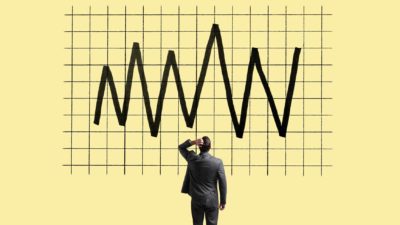It occurred to me this morning that my Monday articles tend to be a little more reflective than those I write during the rest of the week.
Probably influenced by a couple of days off, and a break from the constant flow of news and share prices, my mind has the time and space to turn to the bigger picture.
And that, in a very 'meta' way (as the cool kids say these days), is what I wanted to share with you, today.
On Saturday morning, I sent a tweet (if Trump's election loss makes you unhappy, please avert your eyes):
"I hadn't thought about the US President all week, until now.
First time in about 4 years…
As it should be.
Great to have an adult in the White House…"
And one reply in particular, from property guru Pete Wargent, caught my eye:
"if only the Fed was the same. feels almost like we get hourly updates sometimes"
The Fed, of course, is the US version of our Reserve Bank, the US Federal Reserve.
And Pete's right.
If you want it, not only can you get regular updates from the Fed itself, but you could probably have an endless stream of updates, views and opinions from the phalanx of Fed watchers.
All Fed. All the time.
The same is true, of course, of shares.
The market is open 6 hours a day, 5 days a week. If you're investing in the US, you can double that (and add a little bit for their 'after hours' market).
Then there's the ASX announcements, press releases, newspaper articles, tweets, TV appearances and the rest.
So much information. So little time.
You know what's coming next, right?
Yep.
You could probably get rid of 95% (99%?) of it, and still build (and sustain) a wonderful nest egg.
A bit rich, coming from a bloke who spends his entire working life (and much of my recreation time) thinking about stocks?
Not really.
Most of the thinking I (and the team at The Motley Fool) do is not centred around trying to digest the most recent information.
In fact, we disregard most of it.
Rarely is it new.
Rarely is it impactful.
Rarely is it important to our investment thesis.
And remember… it wasn't always thus.
It really is remarkable how quickly times change.
When I was doing high school economics, there was (kids, cover your eyes) no internet.
No constant stream of ASX announcements. No constant stream of news and views.
The news we did get was via tomorrow's newspaper.
(And, get this: I had to call the investor relations departments to get past copies of company annual reports!)
Now, I think, net-net, things have improved. Easy access to information means less of a 'knowledge gap' between the big end of town and the rest of us.
That's undeniably great.
The downside, of course, is that we've gone from drought to flood, and sometimes just keeping afloat is a challenge, let alone making progress.
The art has gone from 'finding information' to 'working out what to read, and what to discard'.
It's not just an internet problem, either.
BHP Group Ltd (ASX: BHP)'s latest annual reporting papers were – get this – 520 A4 pages long!
In a single pdf.
What Challenger Ltd (ASX: CGF) can't match BHP for in length, it makes up for in the sheer number of dispatches.
In one day in August last year, Challenger released, in different announcements, its Appendix 4E, its Annual Report, its Annual Review, its Market Release, its Investor Presentation and Outlook, its Analyst Pack, its Appendix 4G, its Corporate Governance Report, its Sustainability Report and its Capital Notes Newsletter.
With 10 different documents, spanning more than 350 pages, it's probably no surprise that before the day was out, it had to release an 11th – a correction to one of the aforementioned!
And those reports from BHP and Challenger (just to pick two) are the important stuff, straight from the company, before all of the analyst reports, news articles, opinion pieces and the rest.
You could truly do nothing else but spend your life trying to trawl through them all, and not even succeeding.
I'm not sure if I've written this before, but my boss, Bruce Jackson, is a big fan of 'focus' – not being distracted by things we 'could' do, instead making sure we prioritise the few things that matter most.
It's also a great idea for investors.
Using that idea, there's a line I regularly use which I hope I haven't stolen from someone else: "Scarcity is a wonderful resource".
That is, when you have a limit to the amount of resources (time, people, information) you have, you're forced to prioritise.
Which companies will I dig a little deeper on?
Which source(s) of information will I go to first?
What elements of my experience and education can I use to screen out the poor prospects?
Which people's opinions should I elevate, or ignore?
Those higher-level questions are, to invoke another analogy, the investors' example of the small businesswoman's challenge: working 'in' the business versus working 'on' the business.
Working 'in' the business is doing the stuff that needs doing: buying inventory, running the machinery, serving customers, paying bills and the like.
Working 'on' the business is the higher level stuff: what new products should we make/sell? What resourcing will we need for the next leg of growth? How can we better serve our customers?
The former is ever-urgent. But you can't grow unless you spend time on the latter.
For the investor, the temptation to spend all of our time surfing the wave of information is strong. There's always something else to read, to listen to, to incorporate in an investment thesis. That's the 'day to day'.
But the 'working on' the business version, for investors, is to spend time refining the process. Thinking through the mental models. Working out what information to absorb, and to disregard. What sources to use. How to best filter information.
It's probably no surprise that we're most likely to be able to do that over the weekend, on Monday morning, or in the shower – the times our minds are most free of the 'information wave'.
Yes, information consumption aids learning. Warren Buffett and his lieutenant Charlie Munger are voracious readers. Investing is, to a large extent, a game of incremental accumulation of knowledge.
But, particularly in Munger's case, he reads so incredibly widely that he's essentially 'cross training' to prepare his mind to make better investment decisions.
No, there is no substitute for the hard work of educating yourself; both formally, and by the regular informal acquisition of knowledge.
But if that's all you do, you'll drown in the process, either failing to learn what's truly most important in making investment decisions, or burning yourself out… or both.
The process of creating art requires a lot of attention to detail. But that can only truly be done by stepping back and making sure you can see the whole canvas from time to time.
It's no mistake that investing is more art than science.









